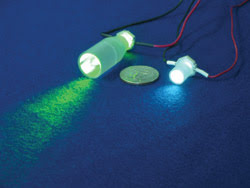Richard Gaughan, Contributing Editor
Even the most sophisticated machine vision system will fail if the lighting isn’t right. Variations in intensity, poor color rendering or even a simple lack of brightness can affect imaging system performance, and any vision system design must consider illumination characteristics. Optimized LED illumination packages offer a new tool for system designers.
At the Photonics West conference in January, Innovations in Optics Inc. of Woburn, Mass., displayed its new LED light engine. The heart of the system is an array of light-emitting diodes that are closely spaced on a header. In the past, such arrays have experienced problems because LEDs emit throughout their volume over essentially the entire hemisphere. Therefore, if neighboring emitters are too close, the adjacent ones absorb emission from each other, reducing the efficiency of the array. In the light engine’s top-emitting LEDs, however, the bulk of the radiation is directed away from the surface of the substrate, allowing them to be more densely spaced and improving net efficiency.

New light engines from Innovations in Optics Inc. display high brightness and controlled illumination. The two standard packages feature 20° and 41° half-angles.
The second element of the system is the primary optic — in this case, a nonimaging optical concentrator, also known as a compound parabolic concentrator. The primary optic efficiently directs the emitted light into a cone with a specified angle. The LED arrays, which feature from 2 × 2 to 20 × 20 elements, emit light over the entire hemisphere, and the concentrator funnels nearly all the output light into a usable cone. Standard cone half-angles are 20° and 41°, but compound parabolic concentrators can be designed for angles of up to 90° and of less than 10°. Their output is practically uniform, exhibiting less than 5 percent intensity variation in the far-field region.
Accurate color rendering is critical for many machine vision applications because apparent color shifts due to the spectral characteristics of the light source degrade the accuracy of color identification. To provide white light, the arrays in the light engine are composed of blue and red LEDs. Some of the blue LEDs are coated with a yellow phosphor. The color-rendering index is as high as 95 (solar illumination is 100) for the white-light engine. Some applications require white light of a different color temperature, however, and this may be achieved by adjusting the relative intensities of the three output colors.
Perhaps the most critical factor in the success of any machine vision illumination system is brightness. Chuck DeMilo, manager of engineering at Innovations in Optics, said that the density of the LED array and the ability to harness the light coming off the array provide the brightest light engine on the market. The company’s standard product line includes a white-light source capable of delivering up to 5 W of optical power or 1500 lumens of photometric intensity. It currently is designing a system with 10 times the brightness and less than half the cone angle of its customer’s existing source.
Contact: Chuck DeMilo, Innovations in Optics Inc., Woburn, Mass.; +1 (781) 933-4477; fax: +1 (781) 933-0007; e-mail: mailto:[email protected].